Evaluation of Remote-Sensing based Estimates of Actual Evapotranspiration over (Diverse Shape and Sized) Palmiet Wetlands
Abstract
:1. Introduction
1.1. Wetland Evapotranspiration
1.2. Use of Remote Sensing for Quantifying Actual Evapotranspiration
- (a)
- To compare ETa data from three remote sensing products for a range of diverse shape and sized wetlands;
- (b)
- To compare/validate the remote sensing-based ETa with limited ETa estimates from ground-based scintillometer data;
- (c)
- To evaluate if ETa over the wetlands is higher than surrounding land cover using remote sensing data for three different sized wetlands.
2. Materials and Methods
2.1. Study Area: Location of Palmiet Wetlands
2.2. Evapotranspiration Data Sources Evaluated
2.2.1. Remote Sensing Data Sources
2.2.2. Scintillometer
2.2.3. Climate Data
2.3. Data Analysis
2.3.1. Comparison of ETa for Palmiet Wetlands from Remote Sensing Datasets
2.3.2. Comparison of ETa from Wetlands with the Surrounding Landscape
3. Results
3.1. Comparison of ETa for Palmiet Wetlands from Remote Sensing Datasets
3.2. Comparison of ETa from Remote Sensing Datasets with Ground Data (Scintillometer)
3.3. Comparison of ETa from Wetlands with the Surrounding Landscape
4. Discussion
4.1. Estimates of Palmiet Wetland ETa from Remote Sensing Products
- −
- MOD16 estimates are generally lower compared to both FruitLook and EEFLUX for the wetlands for most of the study period.
- −
- MOD16 reflects far less seasonal variation in ETa than the other data sets.
- −
- For Clanwilliam wetland located in an arid region, MOD16 outputs display a different seasonal distribution to FruitLook.
- −
- EEFlux estimates are higher compared to both FruitLook and MOD16 for all wetlands for most of the study period.
- −
- For wetlands (a) Helderstroom, (b) Jonkershoek, and (c) Theewaterskloof located in a higher rainfall region, EEFlux data were not sensitive to the hydrological dry year in 2017/2018
- −
- FruitlLook estimates show the highest variability that appears to correspond with water availability in the catchment area, indicating that it is possibly oversensitive to water availability.
- −
- For the three drier catchments (d), (e), and (f), FruitLook estimates show the highest ETa for the arid Clanwilliam wetland (e), compared to the Goukou (d) and Krom (f) wetlands, which is a surprising result given the differences in water availability.
4.2. Influence of Wetland Size and Shape
5. Conclusions
Author Contributions
Funding
Acknowledgments
Conflicts of Interest
References
- Mitsch, W.J.; Gosselink, J.G. Wetlands; John Wiley and Sons, Inc.: Hoboken, NJ, USA, 2015. [Google Scholar]
- Russi, D.; ten Brink, P.; Farmer, A.; Badura, T.; Coates, D.; Forster, J.; Kumar, R.; Davidson, N. The Economics of Ecosystems and Biodiversity for Water and Wetlands. IEEP Lond. Bruss. 2013, 78. Available online: https://www.ramsar.org/sites/default/files/documents/pdf/TEEB/TEEB_Water-Wetlands_Final-Consultation-Draft.pdf (accessed on 31 October 2019).
- Gardner, R.C.; Barchiesi, S.; Beltrame, C.; Finlayson, C.; Galewski, T.; Harrison, I.; Paganini, M.; Perennou, C.; Pritchard, D.; Rosenqvist, A.; et al. State of the World’s Wetlands and Their Services to People: A Compilation of Recent Analyses. 2015. Available online: https://www.ramsar.org/sites/default/files/documents/library/cop12_doc23_bn7_sowws_e_0.pdf (accessed on 31 October 2019).
- Silva, J.P.; Phillips, L.; Jones, W.; Eldridge, J.; O’Hara, E. Life and Europe’s Wetlands: Restoring a Vital Ecosystem; European Commission: Luxembourg, 2007; Available online: https://ec.europa.eu/environment/archives/life/publications/lifepublications/lifefocus/documents/wetlands.pdf (accessed on 31 October 2019).
- Nel, J.L.; Driver, A.; Strydom, W.F.; Maherry, A.; Petersen, C.; Hill, L.; Roux, D.J.; Nienaber, S.; Van Deventer, H.; Swartz, E.; et al. Atlas of Freshwater Ecosystem Priority Areas in South Africa: Maps to Support Sustainable Development of Water Resources; WRC Report TT55/11; Water Research Commission: Pretoria, South Africa, 2011. [Google Scholar]
- Dini, J.; Bahadur, U. South Africa’s national wetland rehabilitation programme: Working for wetlands. In The Wetland Book; Finlayson, C.M., Everard, M., Irvine, K., McInnes, R., Middleton, B., van Dam, A., Davidson, N.C., Eds.; Springer: Dordrecht, The Netherlands, 2016; pp. 1–7. [Google Scholar] [CrossRef]
- Department of Environmental Affairs (DEA). Projects and Programmes: Working for Wetlands. Available online: https://www.environment.gov.za/projectsprogrammes/workingfowetlands (accessed on 17 August 2018).
- Barclay, A. Ecosystem Engineering by the Wetland Plant Palmiet: Does It Control Fluvial Form and Promote Diffuse Flow in Steep-Sided Valleys of the Cape Fold Mountains. Master’s Thesis, Rhodes University, Grahamstown, South Africa, 2016. [Google Scholar]
- Pulley, S.; Ellery, W.N.; Lagesse, J.V.; Schlegel, P.K.; McNamara, S.J. Gully erosion as a mechanism for wetland formation: An examination of two contrasting landscapes. Land Degrad. Dev. 2018, 29, 1756–1767. [Google Scholar] [CrossRef]
- Rebelo, A.J. An Ecological and Hydrological Evaluation of the Effects of Restoration on Ecosystem Services in the Kromme River System, South Africa. Master’s Thesis, Stellenbosch University, Stellenbosch, South Africa, 2012. [Google Scholar]
- Munro, S.L.; Linder, H.P. The embryology and systematic relationships of Prionium serratum (Juncaceae: Juncales). Am. J. Bot. 1997, 84, 850–860. [Google Scholar] [CrossRef] [PubMed]
- Rebelo, A.J.; Morris, C.; Meire, P.; Esler, K.J. Ecosystem services provided by South African palmiet wetlands: A case for investment in strategic water source areas. Ecol. Indic. 2019, 101, 71–80. [Google Scholar] [CrossRef]
- Job, N. Geomorphic Origin and Dynamics of Deep, Peat-filled, Valley Bottom Wetlands Dominated by Palmiet (Prionium serratum)—A Case Study Based on the Goukou Wetland, Western Cape. Master’s Thesis, Rhodes University, Grahamstown, South Africa, 2014. [Google Scholar]
- Smith, C. Determining the Hydrological Functioning of the Palmiet Wetlands in the Eastern and Western Cape of South Africa. Master’s Thesis, Rhodes University, Grahamstown, South Africa, 2019. [Google Scholar]
- Labedzki, L. Evapotranspiration; InTech Publishers: Rijeka, Croatia, 2011. [Google Scholar]
- Reynolds, J.F.; Kemp, P.R.; Tenhunen, J.D. Effects of long-term rainfall variability on evapotranspiration and soil water distribution in the Chihuahuan Desert: A modeling analysis. Plant Ecol. 2000, 150, 145–159. [Google Scholar] [CrossRef]
- Howard-Williams, C. Wetlands and watershed management: The role of aquatic vegetation. J. Limnol. Soc. South. Afr. 1983, 9, 54–62. [Google Scholar] [CrossRef]
- Winter, T.C.; Rosenberry, D.O.; Buso, D.C.; Merk, D.A. Water source to four US wetlands: Implications for wetland management. Wetlands 2001, 21, 462–473. [Google Scholar] [CrossRef]
- Drexler, J.Z.; Snyder, R.L.; Spano, D.; Paw U, K.T. A review of models and micrometeorological methods used to estimate wetland evapotranspiration. Hydrol. Process. 2004, 18, 2071–2101. [Google Scholar] [CrossRef]
- Goulden, M.L.; Litvak, M.; Miller, S.D. Factors that control Typha marsh evapotranspiration. Aquat. Bot. 2007, 86, 97–106. [Google Scholar] [CrossRef]
- Davie, T. Fundamentals of Hydrology, 3rd ed.; Routledge: Oxford, UK, 2008. [Google Scholar]
- Mu, Q.; Zhao, M.; Running, S.W. Improvements to a MODIS global terrestrial evapotranspiration algorithm. Remote. Sens. Environ. 2011, 115, 1781–1800. [Google Scholar] [CrossRef]
- Glenn, E.P.; Huete, A.R.; Nagler, P.L.; Hirschboeck, K.K.; Brown, P. Integrating remote sensing and ground methods to estimate evapotranspiration. Crit. Rev. Plant Sci. 2007, 26, 139–168. [Google Scholar] [CrossRef]
- Jarmain, C.; Mengitsu, M.; Jewitt, G.P.W.; Kongo, V.; Bastiaanssen, W. A Methodology for Near-Real Time Spatial Estimation of Evaporation; WRC Report No. K5/1751:2009; Water Research Commission: Pretoria, South Africa, 2009; ISBN 978-1-77005-725-8. [Google Scholar]
- Bastiaanssen, W.G.M.; Noordman, E.J.M.; Pelgrum, H.; Davids, G.; Thoreson, B.P.; Allen, R.G. SEBAL model with remotely sensed data to improve water-resources management under actual field conditions. J. Irrig. Drain. Eng. 2005, 131, 85–93. [Google Scholar] [CrossRef]
- Allen, R.G.; Tasumi, M.; Trezza, R. Satellite-based energy balance for mapping evapotranspiration with internalized calibration (METRIC)—Model. J. Irrig. Drain. Eng. 2007, 133, 380–394. [Google Scholar] [CrossRef]
- Monteith, J.L. Evaporation and environment. In Symposia of the Society for Experimental Biology; Cambridge University Press: Cambridge, UK, 1965; Volume 19, pp. 205–224. [Google Scholar]
- Samain, B.; Ferket, B.V.; Defloor, W.; Pauwels, V.R. Estimation of catchment averaged sensible heat fluxes using a large aperture scintillometer. Water Resour. Res. 2011, 47. [Google Scholar] [CrossRef]
- Funk, C.; Peterson, P.; Landsfeld, M.; Pedreros, D.; Verdin, J.; Shukla, S.; Husak, G.; Rowland, J.; Harrison, L.; Hoell, A.; et al. The climate hazards infrared precipitation with stations—A new environmental record for monitoring extremes. Sci. Data 2015, 2, 150066. [Google Scholar] [CrossRef] [PubMed]
- Allen, R.G.; Pereira, L.S.; Raes, D.; Smith, M. Crop Evapotranspiration—Guidelines for Computing Crop Water Requirements—FAO Irrigation and Drainage Paper 56; FAO: Rome, Italy, 1998. [Google Scholar]
- Birkhead, A.L.; Olbrich, B.W.; James, C.S.; Rogers, K.H. Developing an Integrated Approach to Predicting the Water Use of Riparian Vegetation; WRC Report 474/1/97; Water Research Commission: Pretoria, South Africa, 1997. [Google Scholar]
- Everson, C.S.; Burger, C.; Olbrich, B.W.; Gush, M.B. Verification of Estimates of Water Use from Riverine Vegetation on the Sabie River in the Kruger National Park; WRC Report 877/1/01; Water Research Commission: Pretoria, South Africa, 2001. [Google Scholar]
- Roberts, J.; Young, B.; Marston, F. Estimating the Water Requirements for Plants of Floodplain Wetlands: A Guide; Land and Water Resources Research and Development Corporation: Canberra, Australia, 2000. [Google Scholar]
- Bullock, A.; Acreman, M. The role of wetlands in the hydrological cycle. Hydrol. Earth Syst. Sci. 2003, 7, 358–389. [Google Scholar] [CrossRef]
- Jarmain, C. Personal Communication; Stellenbosch University: Western Cape, South Africa, 2008. [Google Scholar]
- Rebelo, A.J.; Le Maitre, D.C.; Esler, K.J.; Cowling, R.M. Hydrological responses of a valley-bottom wetland to land-use/land-cover change in a South African catchment: Making a case for wetland restoration. Restor. Ecol. 2015, 23, 829–841. [Google Scholar] [CrossRef]
- Grundling, P.L.; Grundling, A.T.; Pretorius, L.; Mulders, J.; Mitchell, S. South African Peatlands: Ecohydrological Charcteristics and Socio-Economic Value; Water Research Commission: Pretoria, South Africa, 2017; Available online: http://www.wrc.org.za/wp-content/uploads/mdocs/2346-1-17.pdf (accessed on 31 October 2018).
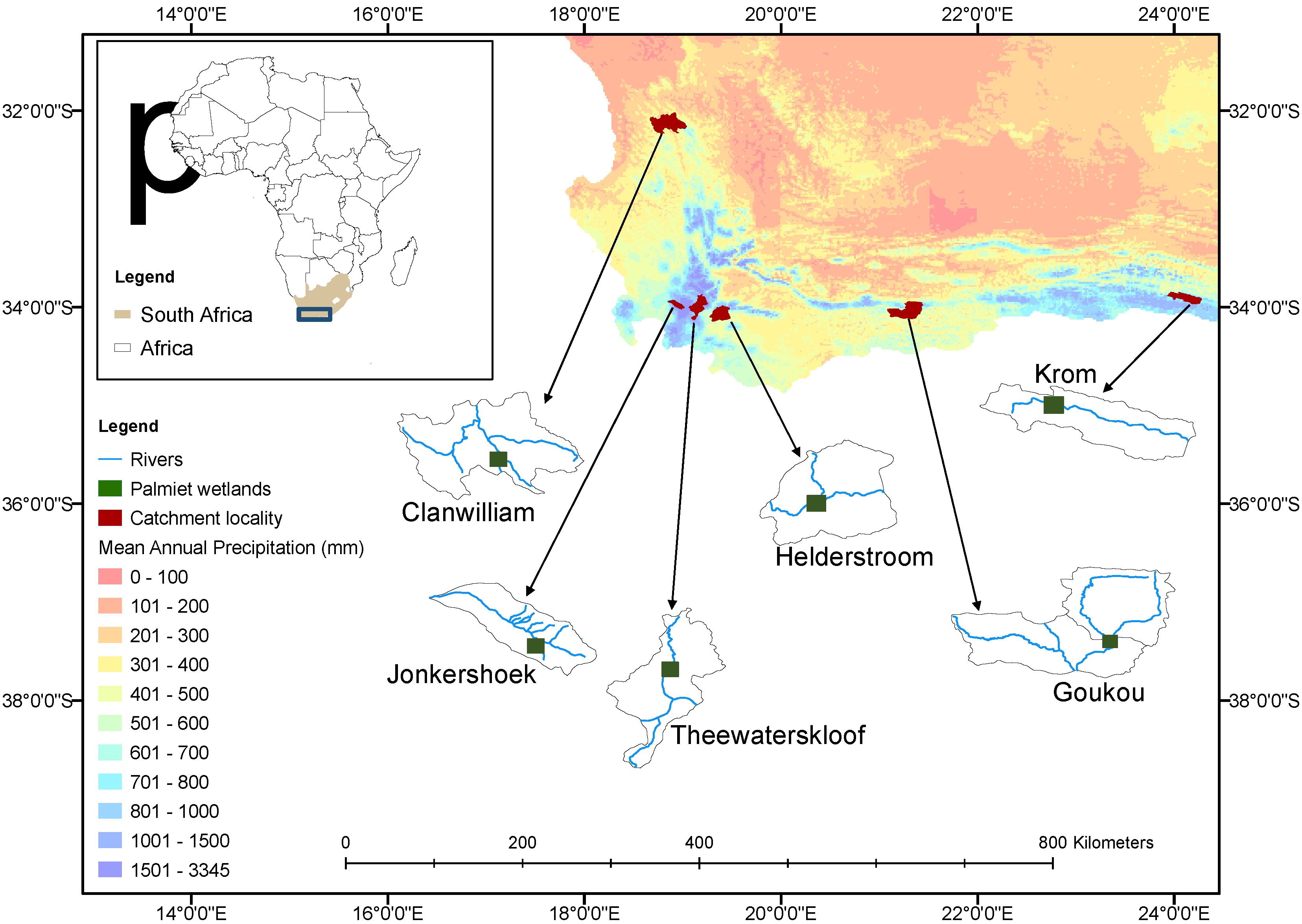

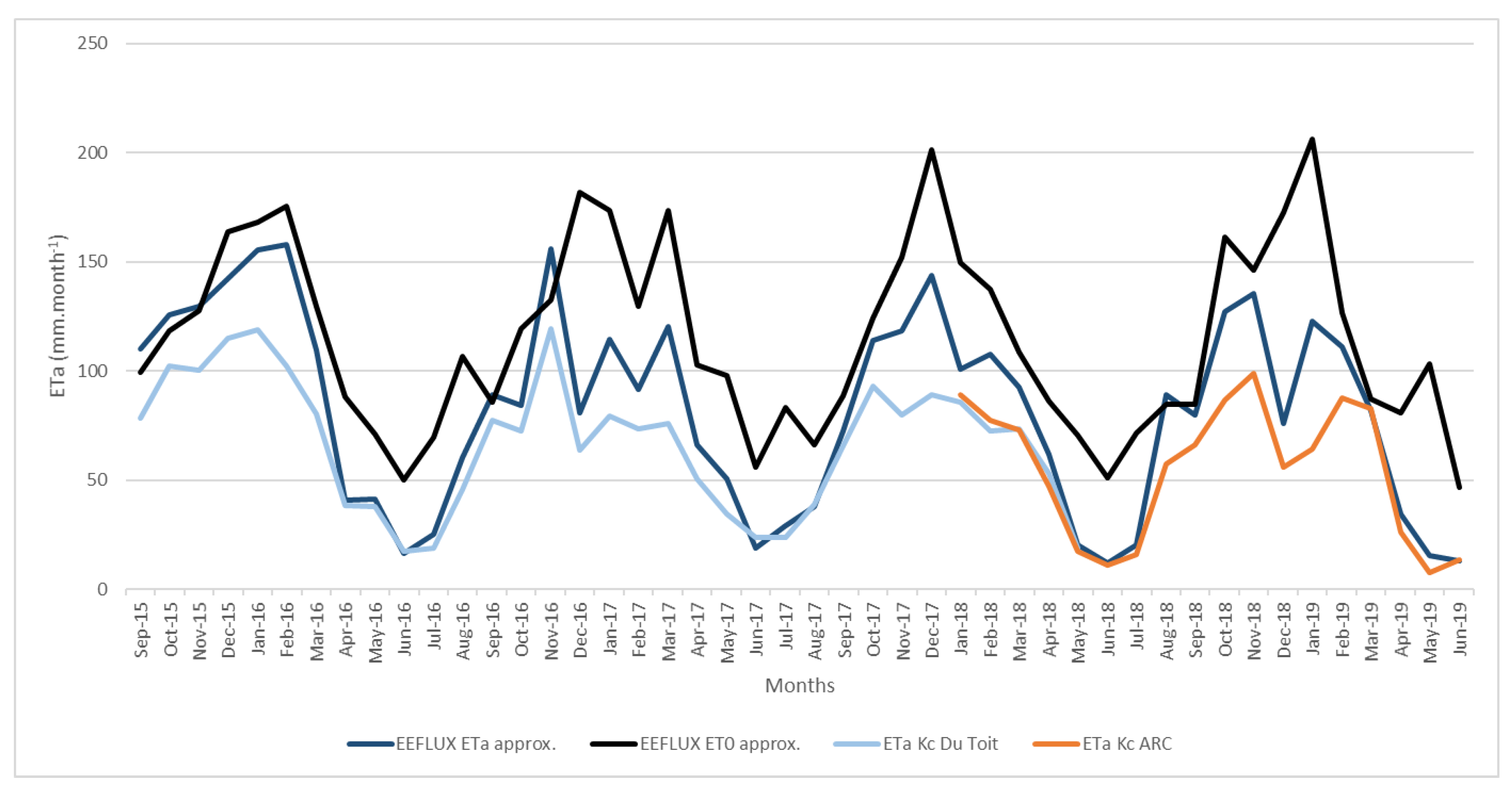
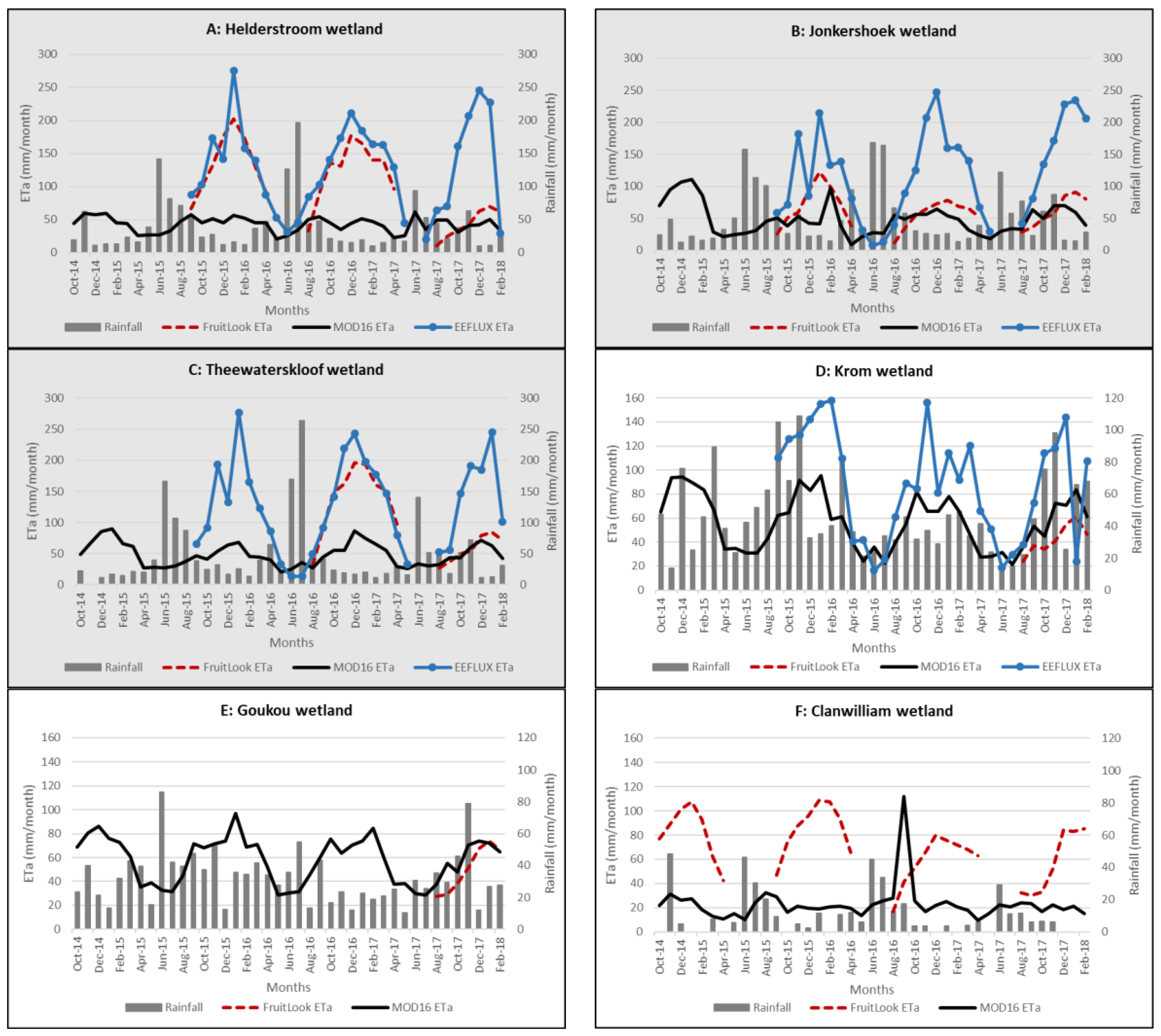
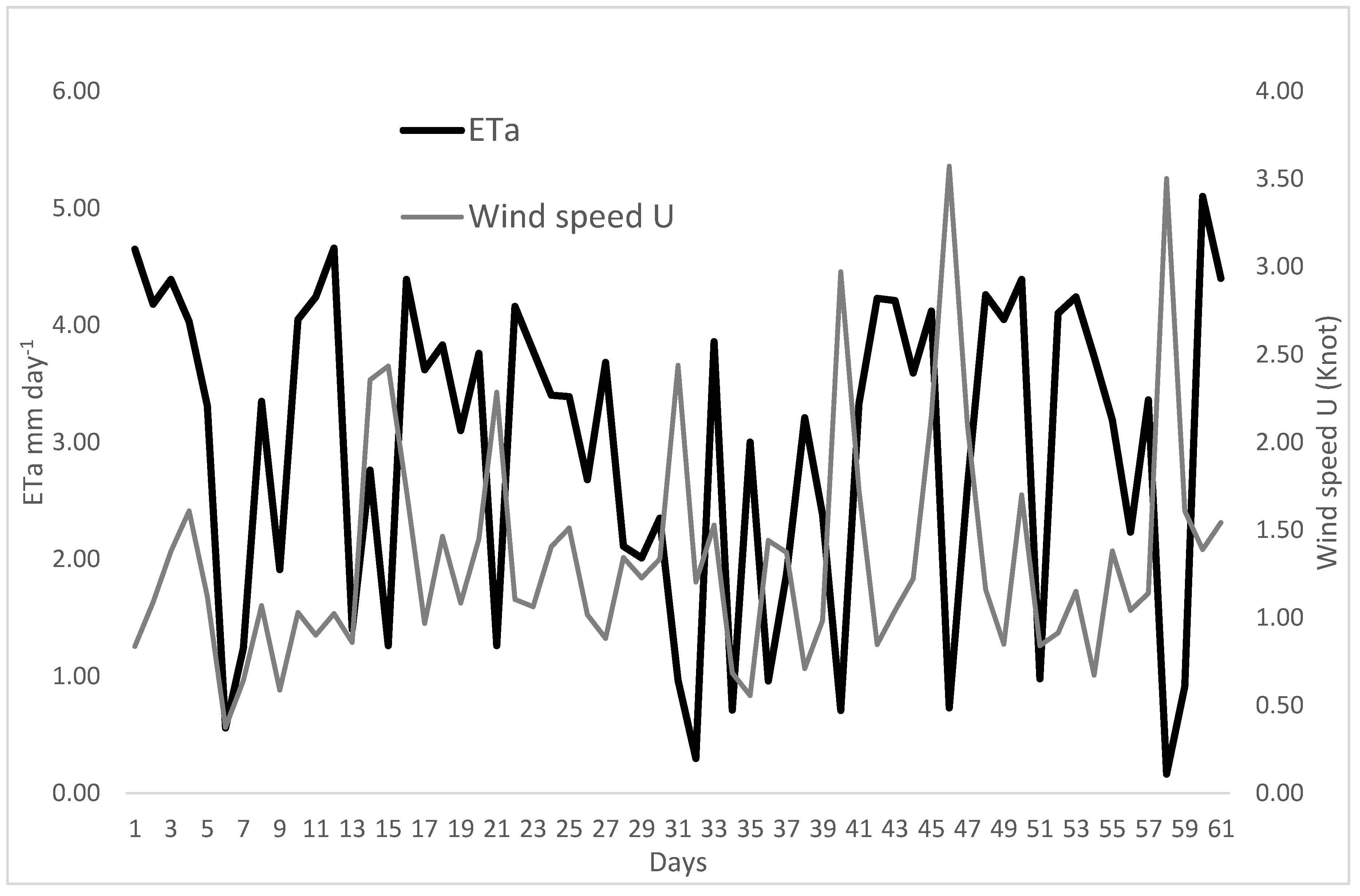

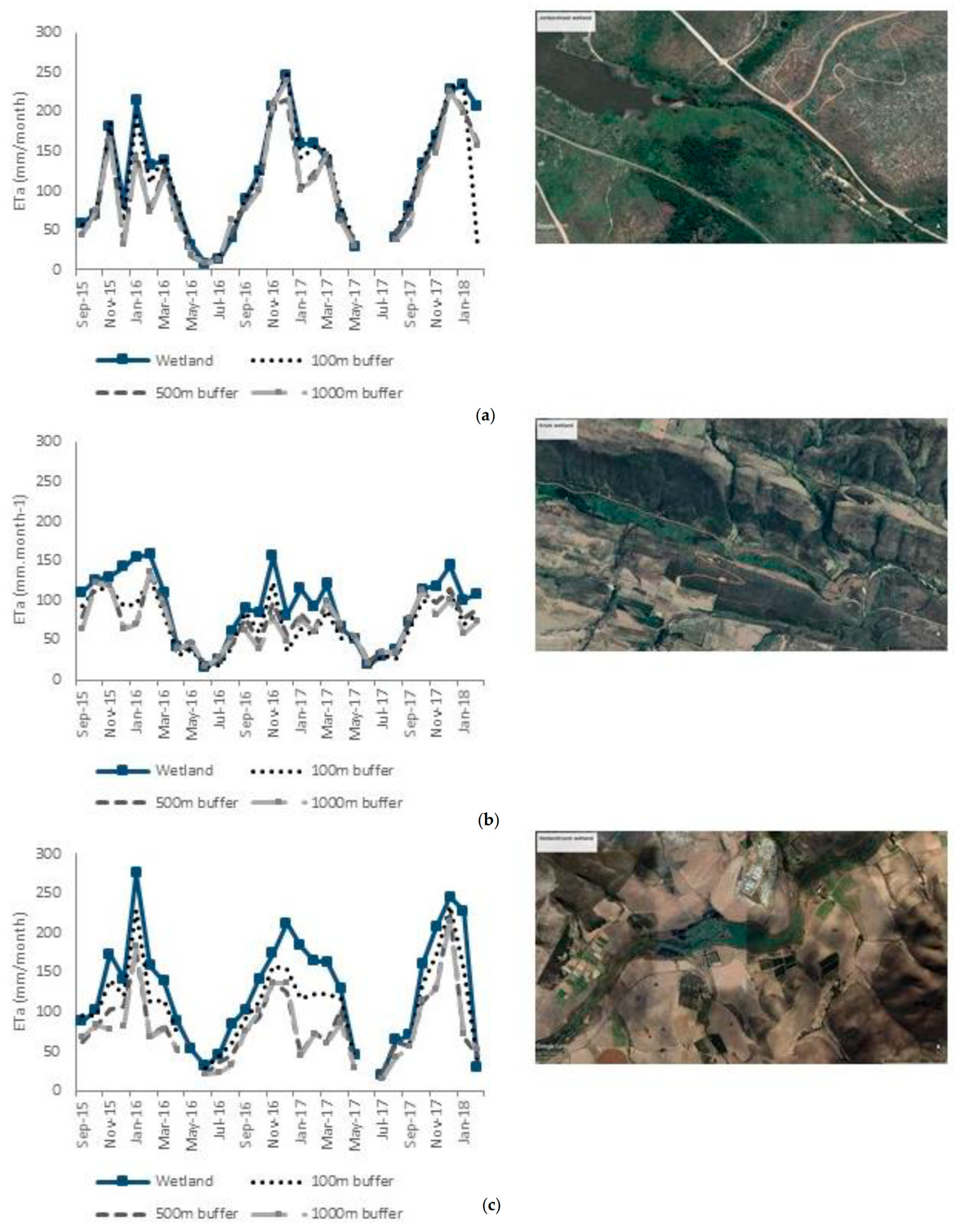
| Wetland Name | Length (m) | Width (m) | Area (m2) | Catchment Area (km2) | Shape |
|---|---|---|---|---|---|
| Jonkershoek | 217 | 39 | 5525.5 | 26.83 |  |
| Clanwilliam | 1213 | 168 | 146,764.0 | 2022.97 |  |
| Theewaterskloof | 1296 | 464 | 363,884.0 | 50.94 |  |
| Goukou | 2101 | 583 | 723,471.0 | 93.16 |  |
| Krom | 5053 | 359 | 1,017,210.0 | 42.82 |  |
| Helderstroom | 4649 | 511 | 1,205,750.0 | 554.69 |  |
| Application/Product | Model | Theoretical Basis | Contributing Satellites | Resolution |
|---|---|---|---|---|
| FruitLook www.fruitlook.co.za | Surface Energy Balance Algorithm for Land (SEBAL) [25] | Surface Energy Balance | Disaster Monitoring Constellation (DMC) sensor and MODIS | Temporal: weekly Spatial: 30–250 m |
| MOD16 ET data product https://developers.google.com/earth-engine/datasets/catalog/MODIS_006_MOD16A2 | MODIS global ET algorithm [22] | Penman-Monteith [27] | MODIS | Temporal: 8 day Spatial: 500 m |
| EEFLUX—Earth Engine Evapotranspiration Flux https://eeflux-level1.appspot.com/ | Mapping Evapotranspiration at high Resolution with Internalized Calibration (METRIC) [26] | Surface Energy Balance | Landsat | Temporal: 16 day Spatial: 30 m |
| FruitLook | MOD16 | EEFlux | ||||
|---|---|---|---|---|---|---|
| 2015/16 | 2016/17 | 2015/16 | 2016/17 | 2015/16 | 2016/17 | |
| Helderstroom | 1006 | 986 | 340 | 286 | 1076 | 1166 |
| Jonkershoek | 537 | 456 | 319 | 334 | 904 | 1105 |
| Theewaterskloof | na | 1110 | 358 | 421 | 1068 | 1204 |
| Krom | na | na | 494 | 431 | 861 | 713 |
| Goukou | na | na | 502 | 466 | nc | nc |
| Clanwilliam | 632 | 478 | 138 | 138 | nc | nc |
| Date | Scintillometer ETa (mm day−1) | Scintillometer ETa (mm 8day−1) | MOD16 ETa (mm 8day−1) | EEFlux Using Landsat 7 (mm day−1) |
|---|---|---|---|---|
| 14 Oct | 2.9 | |||
| 15 Oct | 3.0 | 15.50 | ||
| 16 Oct | 2.8 | |||
| 17 Oct | 5.9 | |||
| 18 Oct | 6.1 | |||
| 19 Oct | 6.3 | |||
| 20 Oct | 3.8 | |||
| 21 Oct | 2.9 | |||
| 22 Oct | 2.0 | |||
| 23 Oct | 32.8 | 13.97 | ||
| 24 Oct | ||||
| 25 Oct | 6.5 | 4.65 | ||
| 26 Oct | ||||
| 27 Oct | ||||
| 28 Oct | 6.0 | |||
| 29 Oct | 5.5 |
| Date | Scintillometer ETa (mm day−1) | EEFlux (mm day−1) | Scintillometer ETa (mm 8day−1) | MOD16 ETa (mm 8day−1) | Scintillometer ETa (mm 7day−1) | Fruitlook (mm 7day−1) |
|---|---|---|---|---|---|---|
| 2019/05/23 | 4.65 | |||||
| 2019/05/24 | 4.18 | |||||
| 2019/05/25 | 4.39 | n/a | 1.98 | |||
| 2019/05/26 | 4.03 | |||||
| 2019/05/27 | 3.31 | |||||
| 2019/05/28 | 0.56 | 21.12 | 11.50 | |||
| 2019/05/29 | 1.24 | 5.85 | ||||
| 2019/05/30 | 3.35 | |||||
| 2019/05/31 | 1.91 | |||||
| 2019/06/01 | 4.05 | |||||
| 2019/06/02 | 4.24 | 22.69 | 6.16 | |||
| 2019/06/03 | 4.66 | |||||
| 2019/06/04 | 1.40 | 20.85 | 11.40 | |||
| 2019/06/05 | 2.76 | 3.00 | ||||
| 2019/06/06 | 1.26 | |||||
| 2019/06/07 | 4.39 | |||||
| 2019/06/08 | 3.62 | |||||
| 2019/06/09 | 3.83 | |||||
| 2019/06/10 | 3.10 | 25.02 | 8.17 | |||
| 2019/06/11 | 3.76 | 22.72 | 15.60 | |||
| 2019/06/12 | 1.26 | |||||
| 2019/06/13 | 4.16 | 1.46 | ||||
| 2019/06/14 | 3.78 | 0.45 | ||||
| 2019/06/15 | 3.40 | |||||
| 2019/06/16 | 3.39 | |||||
| 2019/06/17 | 2.68 | |||||
| 2019/06/18 | 3.68 | 26.11 | 6.89 | 22.35 | 8.36 | |
| 2019/06/19 | 2.11 | |||||
| 2019/06/20 | 2.01 | |||||
| 2019/06/21 | 2.35 | |||||
| 2019/06/22 | 0.97 | |||||
| 2019/06/23 | 0.30 | |||||
| 2019/06/24 | 3.86 | |||||
| 2019/06/25 | 0.71 | 12.30 | 8.85 | |||
| 2019/06/26 | 3.00 | 15.30 | 7.21 | |||
| 2019/06/27 | 0.96 | |||||
| 2019/06/28 | 1.87 | |||||
| 2019/06/29 | 3.21 | |||||
| 2019/06/30 | 2.38 | 1.65 | ||||
| 2019/07/01 | 0.71 | |||||
| 2019/07/02 | 3.33 | 15.46 | 16.00 | |||
| 2019/07/03 | 4.23 | |||||
| 2019/07/04 | 4.21 | 20.90 | 8.52 | |||
| 2019/07/05 | 3.59 | |||||
| 2019/07/06 | 4.12 | |||||
| 2019/07/07 | 0.73 | |||||
| 2019/07/08 | 2.62 | 1.44 | ||||
| 2019/07/09 | 4.26 | 23.76 | 18.30 | |||
| 2019/07/10 | 4.05 | |||||
| 2019/07/11 | 4.39 | |||||
| 2019/07/12 | 0.98 | 24.74 | 7.24 | |||
| 2019/07/13 | 4.10 | |||||
| 2019/07/14 | 4.24 | |||||
| 2019/07/15 | 3.73 | |||||
| 2019/07/16 | 3.19 | 1.90 | 24.68 | 12.80 | ||
| 2019/07/17 | 2.23 | |||||
| 2019/07/18 | 3.36 | |||||
| 2019/07/19 | 0.16 | |||||
| 2019/07/20 | 0.91 | 21.92 | 7.96 |
| Wetland | Jonkershoek | Krom | Helderstroom |
|---|---|---|---|
| ETa data product | EEFLUX | EELUX | EELUX |
| Wetland ETa | 120.5 | 90.4 | 128.1 |
| 100 m buffer | 113.4 | 69.4 | 107.7 |
| 500 m buffer | 104.3 | 71.4 | 82.0 |
| 1000 m buffer | 101.3 | 67.4 | 78.6 |
© 2019 by the authors. Licensee MDPI, Basel, Switzerland. This article is an open access article distributed under the terms and conditions of the Creative Commons Attribution (CC BY) license (http://creativecommons.org/licenses/by/4.0/).
Share and Cite
Ramatsabana, P.; Tanner, J.; Mantel, S.; Palmer, A.; Ezenne, G. Evaluation of Remote-Sensing based Estimates of Actual Evapotranspiration over (Diverse Shape and Sized) Palmiet Wetlands. Geosciences 2019, 9, 491. https://doi.org/10.3390/geosciences9120491
Ramatsabana P, Tanner J, Mantel S, Palmer A, Ezenne G. Evaluation of Remote-Sensing based Estimates of Actual Evapotranspiration over (Diverse Shape and Sized) Palmiet Wetlands. Geosciences. 2019; 9(12):491. https://doi.org/10.3390/geosciences9120491
Chicago/Turabian StyleRamatsabana, Phatsimo, Jane Tanner, Sukhmani Mantel, Anthony Palmer, and Gloria Ezenne. 2019. "Evaluation of Remote-Sensing based Estimates of Actual Evapotranspiration over (Diverse Shape and Sized) Palmiet Wetlands" Geosciences 9, no. 12: 491. https://doi.org/10.3390/geosciences9120491
APA StyleRamatsabana, P., Tanner, J., Mantel, S., Palmer, A., & Ezenne, G. (2019). Evaluation of Remote-Sensing based Estimates of Actual Evapotranspiration over (Diverse Shape and Sized) Palmiet Wetlands. Geosciences, 9(12), 491. https://doi.org/10.3390/geosciences9120491





